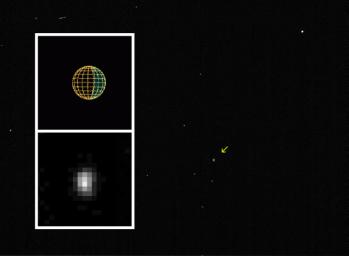
|
Himalia, a Small Moon of Jupiter
- Click the image above for a larger view
- Full-Res JPEG (735 x 540) (29.7 kB)
- Full-Res TIFF (735 x 540) (255.8 kB)
Caption:
NASA's Cassini spacecraft captured images of Himalia, the brightest of Jupiter's outer moons, on Dec. 19, 2000, from a distance of 4.4 million kilometers (2.7 million miles).
This near-infrared image, with a resolution of about 27 kilometers (17 miles) per pixel, indicates that the side of Himalia facing the spacecraft is roughly 160 kilometers (100 miles) in the up-down direction. Himalia probably has a non-spherical shape. Scientists believe it is a body captured into orbit around Jupiter, most likely an irregularly shaped asteroid.
In the main frame, an arrow indicates Himalia. North is up. The inset shows the little moon magnified by a factor of 10, plus a graphic indicating Himalia's size and the direction of lighting (with sunlight coming from the left). Cassini's pictures of Himalia were taken during a brief period when Cassini's attitude was stabilized by thrusters instead of by a steadier reaction-wheel system. No spacecraft or telescope had previously shown any of Jupiter's outer moons as more than a star-like single dot.
Background Info:
Cassini is a cooperative project of NASA, the European Space Agency and the Italian Space Agency. The Jet Propulsion Laboratory, a division of the California Institute of Technology in Pasadena, manages the Cassini mission for NASA's Office of Space Science, Washington, D.C.
Cataloging Keywords:
| Name | Value | Additional Values |
|---|---|---|
| Target | Himalia | Jupiter |
| System | Jupiter | |
| Target Type | Satellite | Irregular, Planet |
| Mission | Cassini-Huygens | |
| Instrument Host | Cassini Orbiter | |
| Host Type | Orbiter | |
| Instrument | Imaging Science Subsystem (ISS) | |
| Detector | ||
| Extra Keywords | Asteroid, Color, Infrared | |
| Acquisition Date | ||
| Release Date | 2001-01-31 | |
| Date in Caption | 2000-12-19 | |
| Image Credit | NASA/JPL/University of Arizona | |
| Source | photojournal.jpl.nasa.gov/catalog/PIA02881 | |
| Identifier | PIA02881 | |
